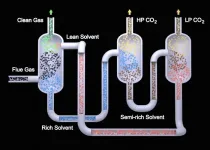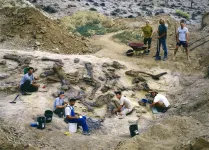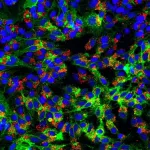(Press-News.org) An enzyme called MARK2 has been identified as a key stress-response switch in cells in a study by researchers at Johns Hopkins Bloomberg School of Public Health. Overactivation of this type of stress response is a possible cause of injury to brain cells in neurodegenerative diseases such as Alzheimer's, Parkinson's, and Amyotrophic Lateral Sclerosis. The discovery will make MARK2 a focus of investigation for its possible role in these diseases, and may ultimately be a target for neurodegenerative disease treatments.
In addition to its potential relevance to neurodegenerative diseases, the finding is an advance in understanding basic cell biology.
The paper describing the discovery appears online March 11 in PLoS Biology.
The study focused on the cellular response to "proteotoxic" stress--a buildup of damaged or aggregated proteins within the main part of the cell, which is a central feature of neurodegenerative diseases. It has been known that cells respond to this type of stress by reducing their production of new proteins, and that a signaling enzyme likely mediates this response. The researchers, after ruling out other signaling enzymes, were able to show that the signaling enzyme MARK2 has this role.
"Further studies of this previously unrecognized signaling pathway should expand our understanding of protein regulation in cells and the role of this process in the development of human diseases," says Jiou Wang, PhD, a professor in the Department of Biochemistry and Molecular Biology at the Bloomberg School.
Together, Alzheimer's, ALS, and other neurodegenerative disorders afflict well over 50 million people worldwide. To date there is no disease-slowing treatment, let alone a cure, for any of them--primarily because their causes are not well understood.
One possible set of causes of neurodegenerative disorders relates to the proteotoxic stress and the response in brain cells. When this response is activated, reducing protein synthesis, it ideally minimizes the protein burden of the cell under proteotoxic stress, thereby allowing it to recover from the stress. But the long-term reduction of protein synthesis could end up starving the cell of needed proteins, injuring it, and potentially triggering cell death. In other cases, the failure of the proteotoxic stress response, rather than its overactivation, may be the problem, so that protein overload leads to cell injury or death.
To fully understand either scenario, scientists need to understand the signaling pathway that senses proteotoxic stress and switches on the proteotoxic stress response. Wang and colleagues in their new study set out to discover it.
Like others in this field, the research team already knew that the molecule at the end of this pathway that switches off protein production is a member of a broad class of signaling enzymes called kinases. They also knew in advance that there are several specific kinases that switch off protein production in the same way, but in response to other types of cellular stress, such as viral infection. The challenge in this study was to find the specific kinase that throws this switch in response to proteotoxic stress in the main part of the cell.
The researchers first identified the kinase MARK2 as one of several candidates for their inquiry by sifting through a large database, produced with prior research, of various kinases and the proteins they potentially act upon. Following up their leads with various cell-free and cell culture experiments, they were able to show that MARK2, and no other candidate kinase, can switch off the protein-making machinery in cells in response to proteotoxic stress, even when the other four known protein-shutdown kinases are absent.
Looking upstream in the signaling pathway, the team found that MARK2 is activated by another signaling kinase, PKCδ, which becomes available for its MARK2-activating role under conditions of proteotoxic stress, thus effectively acting as a proteotoxic stress sensor.
As a preliminary check on the clinical relevance of these findings, the researchers examined a mouse model of familial ALS and samples of spinal cord tissue from human ALS patients. They found evidence that this PKCδ-MARK2 pathway is highly active in these cases compared to non-ALS mice and humans.
"These findings are consistent with the idea that in ALS, for example, this PKCδ-MARK2 pathway is highly active and reducing protein production, which over the long term contributes to the disease process," Wang says.
Having clarified the basics of how this pathway works, Wang and colleagues are now planning to study it in different neurodegenerative disease models to determine whether the pathway could be targeted to treat such diseases.
"I suspect that this PKCδ-MARK2 pathway will ultimately be shown to be relevant not only in neurodegenerative disorders but in many other diseases including cancers," Wang says.
INFORMATION:
"MARK2 Phosphorylates eIF2α in Response to Proteotoxic Stress" was authored by Yu-Ning Lu, Sarah Kavianpour, Tao Zhang, Xumei Zhang, Dao Nguyen, Ravi Thombre, Lu He, and Jiou Wang.
RICHLAND, Wash.--As part of a marathon research effort to lower the cost of carbon capture, chemists have now demonstrated a method to seize carbon dioxide (CO2) that reduces costs by 19 percent compared to current commercial technology. The new technology requires 17 percent less energy to accomplish the same task as its commercial counterparts, surpassing barriers that have kept other forms of carbon capture from widespread industrial use. And it can be easily applied in existing capture systems.
In a study published in the March 2021 edition of International Journal of Greenhouse Gas Control, researchers from the U.S. Department of Energy's Pacific Northwest National Laboratory--along with collaborators from ...
MADISON, Wis. -- Mexican wolves in the American Southwest disappeared more quickly during periods of relaxed legal protections, almost certainly succumbing to poaching, according to new research published Wednesday.
Scientists from the University of Wisconsin-Madison found that Mexican wolves were 121% more likely to disappear -- despite high levels of monitoring through radio collars -- when legal rulings permitted easier lethal and non-lethal removal of the protected wolves between 1998 and 2016. The disappearances were not due to legal removal, the researchers say, but instead were likely caused by poachers hiding evidence of their activities.
The findings suggest that consistently strong protections for endangered predators lead ...
Fossil sites sometimes resemble a living room table on which half a dozen different jigsaw puzzles have been dumped: It is often difficult to say which bone belongs to which animal. Together with colleagues from Switzerland, researchers from the University of Bonn have now presented a method that allows a more certain answer to this question. Their results are published in the journal Palaeontologia Electronica.
Fossilized dinosaur bones are relatively rare. But if any are found, it is often in large quantities. "Many sites contain the remains of dozens of animals," explains Prof. Dr. Martin Sander from the Institute ...
For the first time ever, a Northwestern University-led research team has peered inside a human cell to view a multi-subunit machine responsible for regulating gene expression.
Called the Mediator-bound pre-initiation complex (Med-PIC), the structure is a key player in determining which genes are activated and which are suppressed. Mediator helps position the rest of the complex -- RNA polymerase II and the general transcription factors -- at the beginning of genes that the cell wants to transcribe.
The researchers visualized the complex in high resolution using cryogenic electron microscopy (cryo-EM), ...
Magnetic resonance imaging (MRI) is already widely used in medicine for diagnostic purposes. Hyperpolarized MRI is a more recent development and its research and application potential has yet to be fully explored. Researchers at Johannes Gutenberg University Mainz (JGU) and the Helmholtz Institute Mainz (HIM) have now unveiled a new technique for observing metabolic processes in the body. Their singlet-contrast MRI method employs easily-produced parahydrogen to track biochemical processes in real time. The results of their work have been published in Angewandte ...
At the heart of Cygnus, one of the most beautiful constellations of the summer sky, beats a source of high-energy cosmic ray particles: the Cygnus Cocoon. An international group of scientists at the HAWC observatory has gathered evidence that this vast astronomical structure is the most powerful of our galaxy's natural particle accelerators known of up to now.
This spectacular discovery is the result of the work of scientists from the international High-Altitude Water Cherenkov (HAWC) gamma-ray observatory. Located on the slopes of the Mexican Sierra Negra volcano, the observatory records high-energy particles and photons flowing from the abyss of space. In the sky of the Northern Hemisphere, their brightest source is the region known as the Cygnus Cocoon. At the HAWC, it was established ...
Geologists have long thought tectonic plates move because they are pulled by the weight of their sinking portions and that an underlying, hot, softer layer called asthenosphere serves as a passive lubricant. But a team of geologists at the University of Houston has found that layer is actually flowing vigorously, moving fast enough to drive plate motions.
In their study published in Nature Communications, researchers from the UH College of Natural Sciences and Mathematics looked at minute changes in satellite-detected gravitational pull within the Caribbean and at mantle tomography images - similar to a CAT Scan - of the asthenosphere under the Caribbean. They found ...
Alexandria, Va., USA -- Oral mucositis and taste dysfunction (dysgeusia) occurs in nearly all patients receiving head and neck radiotherapy and tremendously affects the quality of life and treatment outcome. The study "LiCl Promotes Recovery of Radiation-Induced Oral Mucositis and Dysgeusia" published in the Journal of Dental Research (JDR), investigated the hypothesis that lithium chloride (LiCl) can promote the restoration of oral mucosa integrity and taste function after radiation.
LiCl is a potent activator of a key cell signaling pathway called Wnt/β-catenin that is critical for the development, regeneration and function of many tissue types. ...
BUFFALO, N.Y. - A University at Buffalo researcher's recent work on dyslexia has unexpectedly produced a startling discovery which clearly demonstrates how the cooperative areas of the brain responsible for reading skill are also at work during apparently unrelated activities, such as multiplication.
Though the division between literacy and math is commonly reflected in the division between the arts and sciences, the findings suggest that reading, writing and arithmetic, the foundational skills informally identified as the three Rs, might actually overlap in ways not previously imagined, let alone experimentally validated.
"These findings floored me," said Christopher McNorgan, PhD, the paper's author and an assistant professor in UB's Department of Psychology. "They elevate the ...
Researchers at Princeton have determined how five cellular proteins contribute to an essential step in the life cycle of hepatitis B virus (HBV). The article describing these findings appeared March 11, 2021 in the journal Nature Communications.
Viruses have been with us, shaping our lives, societies and economies for millennia. While some viruses rapidly explode onto the world stage, others smolder in our communities for decades, shattering lives but making few headlines. Hepatitis B virus hasn't caused any nationwide lockdowns or stock market crashes because it is slow to spread from person to person and is rarely immediately fatal. It is nonetheless incredibly damaging because it can establish lifelong chronic infection ...




